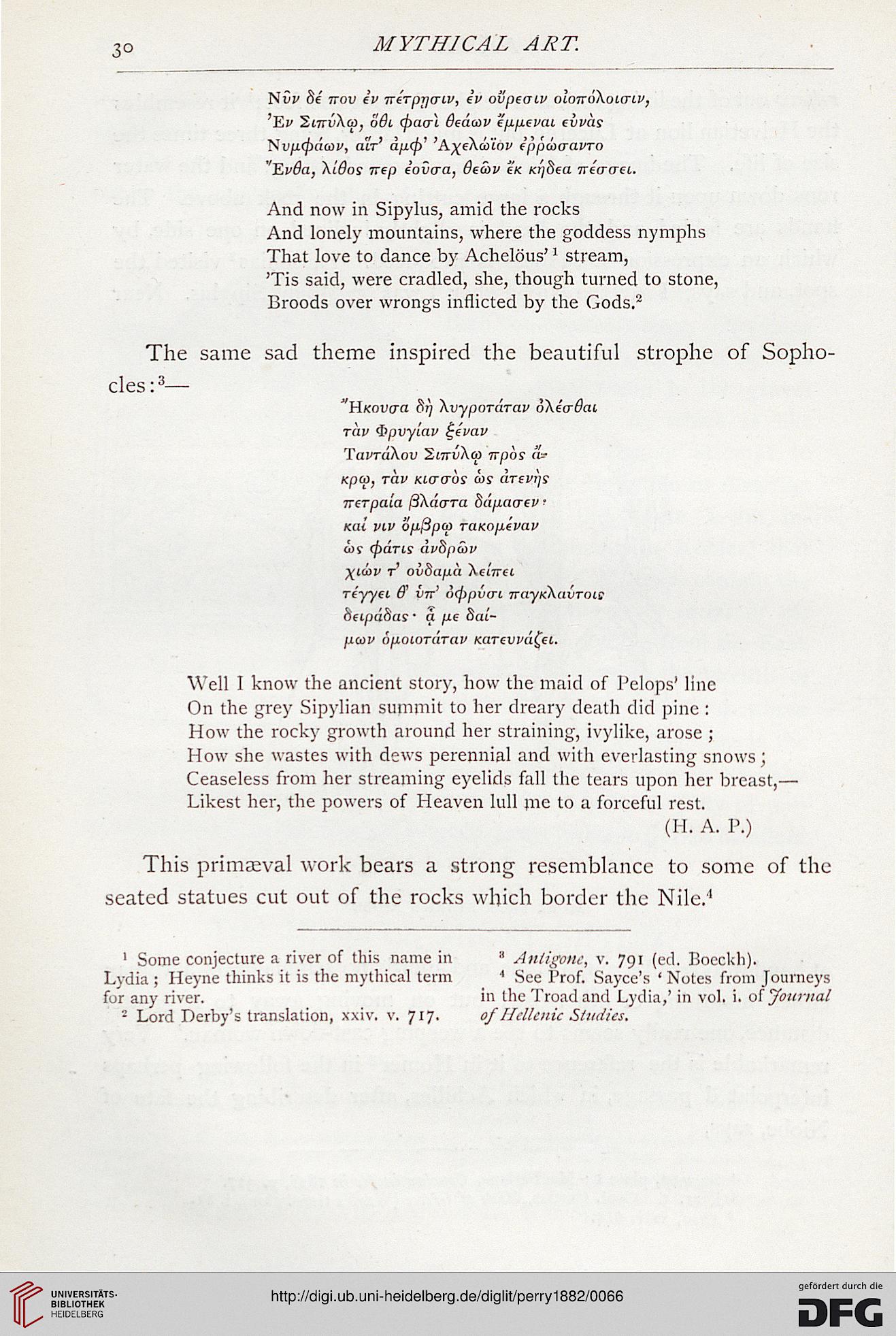3°
MYTHICAL ART.
Nvf 5f nov iv Trerpyo-tv, £v ovptotv oloTrokourLV,
'Ei* 2lttv\(o, '68l <pa&\ Oeaav tpptuai evvas
~Svp<pdcoi>, air' dptfi' ,A^eXa)i'oi' eppdxjavro
''TLvBa, \18os nep eovcra, $ecoz> €K Kt]8ea irtairzi.
And now in Sipylus, amid the rocks
And lonely mountains, where the goddess nymphs
That love to dance by Achelous'1 stream,
'Tis said, were cradled, she, though turned to stone,
Broods over wrongs inflicted by the Gods.2
The same sad theme inspired the beautiful strophe of Sopho-
cles:3—
"Hxowa Sfj \vypoTUTav oXftrdaL
rait <f?pvyiav £tvav
Tavriikov 1nrv\a> wpos «=•
Kpco, rav kmt<t6s <os arewjs
7t€rpa[a ftkdara Sdpcurev i
Kat viif opftpcp TciKopevav
o)f (pans dvhpwv
xlwv T Ovhlipit (TTft
Ttyya ff v7t! n(f>pv<ri nciyK\(tvToie
ba.pd$as ' a /ie <W-
pcou SUotorarav Karcwdfai.
Well I know the ancient story, how the maid of Pelops' line
On the grey Sipylian summit to her dreary death did pine :
How the rocky growth around her straining, ivylike, arose ;
How she wastes with dews perennial and with everlasting snows;
Ceaseless from her streaming eyelids fall the tears upon her breast,—
Likest her, the powers of Heaven lull me to a forceful rest.
(H. A. P.)
This primaeval work bears a strong resemblance to some of the
seated statues cut out of the rocks which border the Nile.'1
1 Some conjecture a river of this name in 3 Antigone, v. 791 (ed. Bocckh).
Lydia ; Heyne thinks it is the mythical term * See Prof. Sayce's ' Notes from Journeys
for any river. in the Troadand Lydia,' in vol. i. of Journal
• Lord Derby's translation, xxiv. v. 717. of Hellenic Studies.
MYTHICAL ART.
Nvf 5f nov iv Trerpyo-tv, £v ovptotv oloTrokourLV,
'Ei* 2lttv\(o, '68l <pa&\ Oeaav tpptuai evvas
~Svp<pdcoi>, air' dptfi' ,A^eXa)i'oi' eppdxjavro
''TLvBa, \18os nep eovcra, $ecoz> €K Kt]8ea irtairzi.
And now in Sipylus, amid the rocks
And lonely mountains, where the goddess nymphs
That love to dance by Achelous'1 stream,
'Tis said, were cradled, she, though turned to stone,
Broods over wrongs inflicted by the Gods.2
The same sad theme inspired the beautiful strophe of Sopho-
cles:3—
"Hxowa Sfj \vypoTUTav oXftrdaL
rait <f?pvyiav £tvav
Tavriikov 1nrv\a> wpos «=•
Kpco, rav kmt<t6s <os arewjs
7t€rpa[a ftkdara Sdpcurev i
Kat viif opftpcp TciKopevav
o)f (pans dvhpwv
xlwv T Ovhlipit (TTft
Ttyya ff v7t! n(f>pv<ri nciyK\(tvToie
ba.pd$as ' a /ie <W-
pcou SUotorarav Karcwdfai.
Well I know the ancient story, how the maid of Pelops' line
On the grey Sipylian summit to her dreary death did pine :
How the rocky growth around her straining, ivylike, arose ;
How she wastes with dews perennial and with everlasting snows;
Ceaseless from her streaming eyelids fall the tears upon her breast,—
Likest her, the powers of Heaven lull me to a forceful rest.
(H. A. P.)
This primaeval work bears a strong resemblance to some of the
seated statues cut out of the rocks which border the Nile.'1
1 Some conjecture a river of this name in 3 Antigone, v. 791 (ed. Bocckh).
Lydia ; Heyne thinks it is the mythical term * See Prof. Sayce's ' Notes from Journeys
for any river. in the Troadand Lydia,' in vol. i. of Journal
• Lord Derby's translation, xxiv. v. 717. of Hellenic Studies.




